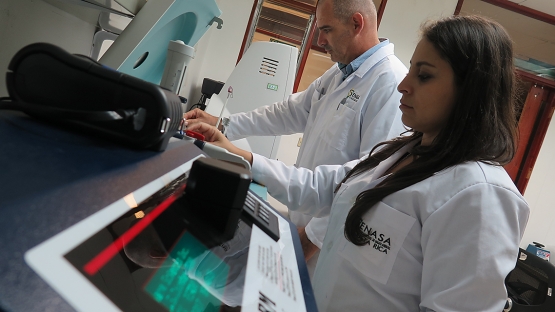Costa Rica no longer depends on laboratories abroad to guarantee food safety and to stay competitive thanks, in part, to nuclear technology and to the support of the IAEA and the Food and Agriculture Organization of the United Nations (FAO).
“We analyse 310 samples a month, 25% more than we did two years ago,” said Yajaira Salazar, food safety expert at Costa Rica’s National Laboratory for Diagnosis and Research in Animal Health (LANASEVE), while walking in her lab amid polished machines and flashing green lights. Salazar and her colleagues have participated in several IAEA training courses and fellowships and can now perform marine biotoxin analysis and quality management, among others.
Pesticides, veterinary drug residues, heavy metals, marine biotoxins, and other organic and inorganic pollutants can all contaminate our food. “To detect these, Costa Rica needs the finest, newest technology manned by well-trained personnel,” said Marietta Ureña Brenes, Director of LANASEVE. “We need to stay ahead of the game.”
Since 2015, LANASEVE’s experts have been learning the latest nuclear and conventional analytical technology to detect contaminants and residues in food, receiving state-of-the-art equipment and expertise through an IAEA technical cooperation project. This food safety facelift has helped Costa Rica’s consumers, producers and exporters alike.
Fish and Cows
To Costa Rican fish producers, sending their samples for analysis to LANASEVE instead of abroad means less money and a shorter turnaround time. While they used to send almost 200 samples a year to laboratories in Ecuador and Chile to check for suspicious harmful substances and comply with EU rules, now LANASEVE analyses these in Heredia north of San José, saving each producer at least EUR 27 000 per year.
Meat producers are also benefiting from these new analytical services. CIISA, a Costa Rican company that sells beef and pork in the country, the USA, Russia and Europe, among others, also depends on LANASEVE’s precise nuclear and isotopic analytical technology to ensure its products are innocuous and meet market requirements.
“It’s better to prevent than to cure,” said María José Arroyo, quality expert at CIISA. Every week, veterinary inspectors prepare samples of beef and pork for LANASEVE to collect and analyse, a service they could not receive before.
Globally, technology is getting better at detecting very small traces of residues in food, which is a good thing for consumers, but which means that codes are getting stricter for exporters.







